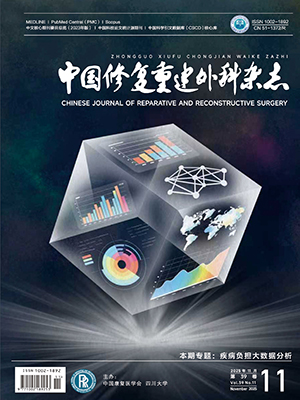Objective To study the effectiveness of artificial disc replacement for cervical diseases and the adjacent segment degeneration. Methods Between January 2008 and October 2010, 39 cases of cervical spondylosis underwent cervical disc replacement. Of them, there were 20 males and 19 females with an average age of 45.7 years (range, 32-60 years)
and an average disease duration of 30 months (range, 1 month to 10 years), including 26 cases of cervical myelopathy, 11 cases of nerve root cervical spondylosis, and 2 cases of mixed cervical spondylosis. Single level disc lesion was observed in 27 cases while bi-level lesion in 12 cases. Prestige disc prosthesis was used in 9 patients, Prodisc-C prosthesis in 4 patients, and Discover disc prosthesis in 26 patients. The neurological functional recovery was assessed after operation by Japanese Orthopaedic Association (JOA) score. The range of motion of replaced segment and adjacent segments was measured (Cobb angle), and Kellgren’s X-ray assessment was used to evaluate the degree of adjacent segment degeneration. Results The operation was successfully performed in all cases, with primary heal ing of all the incisions. All patients were followed up from 12 to 36 months with an average of 23.1 months. JOA score was significantly improved at last follow-up when compared with preoperative score (P lt; 0.05), and no significant difference was observed in the Cobb angle of replaced segment and adjacent segments between pre- and postoperation (P gt; 0.05). According to the Kellgren’s X-ray assessment, degeneration of the adjacent segments occurred in 5 cases at last follow-up, including 3 cases of degeneration from grade 0 to grade 1 or 2, 1 from grade 1 to grade 2, and 1 from grade 2 to grade 3, with a degeneration rate of 12.8%, but no significant difference was found in degeneration degree when compared with preoperative value (χ2=1.793,P=0.406). No degeneration of adjacent segments occurred in 32 patients at 15 months after operation. Conclusion Artificial disc replacement has a good effectiveness in treating cervical spondylosis, which can maintain the range of motion of the replaced segment and adjacent segments, and may have a protective effect on adjacent segment discs.
Citation: LIU Yapu,XIA Hong,AI Fuzhi,SHI Lin,SUI Wenyuan.. ADJACENT SEGMENT DEGENERATION AFTER CERVICAL ARTIFICIAL DISC REPLACEMENT AT EARLYMID-TERM FOLLOW-UP. Chinese Journal of Reparative and Reconstructive Surgery, 2012, 26(4): 385-389. doi: Copy
Copyright © the editorial department of Chinese Journal of Reparative and Reconstructive Surgery of West China Medical Publisher. All rights reserved




